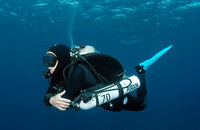Ulfhedinn
-Skill Collector-
Does anyone breath 5mins or so of 100% 02 between dives? Seems like it would assist in lowering your PG. Is my thinking off>?
Welcome to ScubaBoard, the world's largest scuba diving community. Registration is not required to read the forums, but we encourage you to join. Joining has its benefits and enables you to participate in the discussions.
Benefits of registering include
5 minutes of surface O2 is not enough to mean much. But 10 minutes of O2 at twenty feet might well be. Surface O2 can be a helpful adjunct for scrubbing out excess nitrogen, for example two hours of surface oxygen (honest 100%) will remove enough nitrogen to take you from USN Repetitive Group N down to Repetitive Group A. Some physicians will warn that the use of surface oxygen is a bad idea because it could mask DCS symptoms that will be exacerbated on a subsequent dive.No, your thinking is not off. Given a "normal," "no-decompression" style dive, (in which pulmonary oxygen toxicity is not a concern - in other words, that you haven't already exposed yourself to too many hours of oxygen (PPO2's)), 100% oxygen delivery will always help flush nitrogen out of your body, which in simple terms means the lowering of your pressure group. This, in theory, is a good idea.
However, in practice, it's a problem because the benefits are negligible as compared to the costs. Firstly, oxygen delivery at the surface means that you're tied to a tank and regulator of some sort. If you weren't on oxygen, you could function normally, take the time to change out your tank, discuss the dive and plan for the next one, get some munchies and Gatorade, etc... You know, all the things you normally do during surface interval. Secondly, the cost of refilling 100% oxygen (or for that matter, any enriched oxygen supply) is an expense you can not ignore. Thirdly, the benefits are negligible... You might reach a desired pressure group in 40 minutes, rather than an hour, for example. Someone with the right software will have to plug the numbers in for you to get actual times - I'm only estimating.
...So should you do it? Your call. I would recommend the simplest philosophy while diving, which includes waiting a few minutes longer on your surface interval, rather than buying the extra kit, toting it around, being tied to a tank during surface interval, and then, of course, having to refill it.
5 minutes on it? Yeah, it'd work - maybe 80% of the effectiveness as being on it your whole surface interval - but you'd still have all of the disadvantages, saving yourself only being tethered to a bottle for 40 minutes and maybe a reduction in cost. One of the reasons that it works so well in decompression diving is because you're not only breathing it, but also reducing your intake of nitrogen at depth by replacing a gas with nitrogen in it for a gas with no nitrogen in it. In short, you're better off switching to a decompression bottle - say, 50% O2 at 70' - than you are breathing 100% oxygen at the surface, after you've already ongassed the nitrogen.
Simplest way - wait it out. You'll want an hour surface interval anyway to switch tanks and all that jazz. The idea of adding 100% (and 50% is almost as effective, has a deeper operational depth, and can be had easier) really only becomes a big benefit to you at depth.
...And for that, I recommend professional training. Start with a nitrox course and move into a "technical" course where they teach staged decompression diving.

There is NOTHING to doing this....The pre-requisite is that you must have good bouyancy skills, and be able to hold your 20 foot stop depth within 5 feet, no matter what. As this is incredibly easy for an advanced diver ( if it is NOT easy, the person is NOT an advanced diver !!!!!) , this is a great solution for you.
